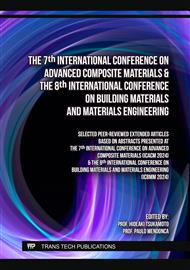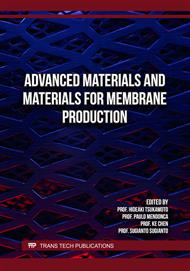[1]
J. V. S. Metekong, C.R Kaze, A. Adesina, J.G.D. Nemale, J.N.Y. Djobo, P.N. Lemougna, T. Alomayri, E. Kamseu, U.C. Melo, and T.T. Tatietse, "Influence of Thermal Activation and Silica Modulus on the Properties of Clayey-Lateritic Based Geopolymer Binders Cured at Room Temperature," Silicon, vol. 14 (2022) no. 13, p.7399–7416
DOI: 10.1007/s12633-021-01566-7
Google Scholar
[2]
J. Davidovits, "Geopolymers: inorganic polymeric new materials," J Therm Anal Calorim, vol. 37.8, p.1633–1656, 1991.
DOI: 10.1007/bf01912193
Google Scholar
[3]
Maignien and Roger, "Review of research on laterites; Natural resources research," United Nations Educ Sci Cult Organ Vaillant-Carmanne, vol. 4 (1966) p.1–156.
Google Scholar
[4]
P. N. Lemougna, U. F. C. Melo, E. Kamseu, and A. B. Tchamba, "Laterite based stabilized products for sustainable building applications in tropical countries: Review and prospects for the case of Cameroon," (2011), MDPI.
DOI: 10.3390/su3010293
Google Scholar
[5]
A. G. Mimboe, M. T. Abo, J. N. Y. Djobo, S. Tome, R. C. Kaze, and J. G. N. Deutou, "Lateritic soil based-compressed earth bricks stabilized with phosphate binder," Journal of Building Engineering, vol. 31 (2020), p.101465.
DOI: 10.1016/j.jobe.2020.101465
Google Scholar
[6]
S. N. Tantono, P. D. Belibi Belibi, J. Baenla, and A. Elimbi, "Alkaline and Acid Activations of Calcined Laterites: A Comparative Study," Silicon, vol. 15 (2023) no. 6, p.2797–2810.
DOI: 10.1007/s12633-022-02211-7
Google Scholar
[7]
L. Valentini, L. Mascarin, M. C. Dalconi, E. Garbin, G. Ferrari, and G. Artioli, "Performance and properties of alkali-activated blend of calcined laterite and waste marble powder," in Proceedings of the 3rd International Conference on Calcined Clays for Sustainable Concrete, Singapore: Springer (2020), p.375–380.
DOI: 10.1007/978-981-15-2806-4_44
Google Scholar
[8]
Keskinkilic E., Pournaderi S., and Geveci A., and Topkaya Y.A., "Calcination characteristics of laterite ores from the central region of Anatolia," Journal of the Southern African Institute of Mining and Metallurgy, vol. 112 (2012), no. 10, p.877–882.
DOI: 10.1002/9781118062081.ch38
Google Scholar
[9]
M. N., Z. H. and P. S. Hadi, "Optimum mix design of geopolymer paste and concretes cured in ambient condition based on compressive strength, setting time and workability," Journal of Building engineering, vol. 23, pp.301-313., 2019.
DOI: 10.1016/j.jobe.2019.02.006
Google Scholar
[10]
R. N. Thakur and S. Ghosh, "Effect of mix composition on compressive strength and microstructure of fly ash based geopolymer composites," Journal of Engineering and Applied Sciences, vol. 4, no. 4, p.68–74, 2009.
Google Scholar
[11]
S. V. Patankar, S. S. Jamkar, And Y. M. Ghugal, "Effect of Water-to-Geopolymer Binder Ratio on The Production of Fly Ash Based Geopolymer Concrete," International Journal of Advanced Technology in Civil Engineering, Oct. (2012) p.296–300.
DOI: 10.47893/ijatce.2012.1048
Google Scholar
[12]
K. M. Prasanna, B. P. Sharath, H. Choukade, K. N. Shivaprasad, B. B. Das, and G. Mahesh, "Research on Setting Time, Compressive Strength and Microstructure of Fly Ash-Based Geopolymer Mixture Containing Slag," Iranian Journal of Science and Technology - Transactions of Civil Engineering, vol. 47, no. 3, p.1503–1517, Jun. (2023)
DOI: 10.1007/s40996-022-01010-9
Google Scholar
[13]
S. Y. Kwek, H. Awang, and C. B. Cheah, "Influence of liquid-to-solid and alkaline activator (Sodium silicate to sodium hydroxide) ratios on fresh and hardened properties of alkali-activated palm oil fuel ash geopolymer," Materials, vol. 14, no. 15, Aug. 2021.
DOI: 10.3390/ma14154253
Google Scholar
[14]
South African Standards, SANS50196-1: 2006 Methods of testing cement. Part 1, Determination of Strength (2006).
Google Scholar
[15]
Standards South Africa, Methods of testing cement. Part 3, Determination of setting times and soundness. Standards South Africa, 2006.
Google Scholar
[16]
ASTM: C 1437-07, "Standard Test Method for Flow of Hydraulic Cement Mortar 1" (2007).
Google Scholar
[17]
O. A. Mohamed, Omar Najm, Haya A. Zuaiter, Syed K. Saleem, and Sven Ivak, and Khaled Al-Aribe, "Effect of activator concentration on setting time, workability and compressive strength of sustainable concrete with alkali-activated slag binder," in Materials Today: Proceedings, 2024.
DOI: 10.1016/j.matpr.2024.04.103
Google Scholar
[18]
H. E. Elyamany, A. E. M. Abd Elmoaty, and A. M. Elshaboury, "Setting time and 7-day strength of geopolymer mortar with various binders," Constr Build Mater, vol. 187, p.974–983, Oct. 2018.
DOI: 10.1016/j.conbuildmat.2018.08.025
Google Scholar
[19]
K. Ghosh and P. Ghosh, "Effect of Na2O/Al2O3, SiO2/Al2O3 And w/b ratio on setting time and workability of fly ash based geopolymer." International Journal of Engineering Research and Applications 2, Vol. 2, July-August (2012), no 4pp.2142-2147
Google Scholar
[20]
South African Bureau of Standards., Code of practice: the structural use of masonry. Part 1, Unreinforced masonry walling. South African Bureau of Standards, 1980.
Google Scholar



